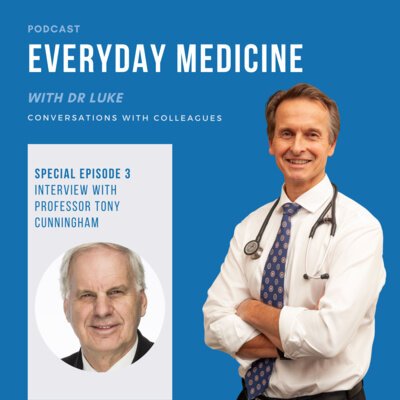Everyday Medicine by Dr Luke Crantock
Conversations with colleagues providing helpful ideas and advice in healthcare
Special Episode 8. Myocarditis and Pericarditis in COVID19 patients with Dr James Sapontis
Covid vaccine induced Pericarditis-Myocarditis
Since the release of mRNA vaccines medical practitioners around the world have been receiving calls from patients complaining of chest discomfort typical of pericarditis some of these patients have also had associated ECG changes and cardiac enzyme elevation consistent with myocarditis. This phenomenon does not appear to be related to the non mRNA vaccines available.
Episode 55. Polyps with Dr Geetha Gopalsamy
Polyps are discreet mass lesions that protrude into the intestinal lumen and represent a very important precancerous pathology to be identified and removed at colonoscopy. Up to 95% of adenocarcinomas arise from polyps, such cancers develop either after inactivation of the APC gene (for adenomas) or by KRAS mutation or BRAF oncogene activation with methylation of promoter regions for the serrated polyp pathway. As colorectal cancer is one of the most commonly diagnosed cancers in Australia, with up to 1 in 18 males and 1 in 25 females developing cancer in their lifetime, identification and removal of polyps as demonstrated by the National Polyp Study remains an important objective at colonoscopy
Episode 54. Varicose Veins with Dr Louis Louizou
Up to 23% or more of Australians have varicose veins which may include small spider telangiectasias to large cosmetically challenging varicosities. In this episode we talk with phlebologist Louis Loizou who runs a very successful vein solution clinic in the community where he manages patients with all presentations of varicose veins, large, small, spider veins – he is able to find a solution for all. Louis is a past vice president and honorary secretary of the Australian College of Phlebology.
Special Episode 7: COVID19 now and in the future with Professor Erwin Loh
Newfound freedom from lockdown in both Victoria and New South Wales will undoubtedly lead to greater COVID-19 exposure. Whilst widespread vaccination uptake has been achieved a significant number of adults and our children remain unvaccinated and vulnerable to the Delta strain. What can we expect from the health perspective for those exposed?
Episode 53. Drug Harm Reduction with Gyu Lee
In this podcast we have a conversation with Gyu Lee who works with Victoria Alcohol and Drug Counselling Service as a harm reduction practitioner managing patients in the community who have developed addictions to both alcohol and drugs. Management techniques include close engagement with referred clients and an approach based on:
Episode 52. Globus with Mr Adnan Safdar
Globus pharyngeus in an intermittent or persistent non-painful sensation of a lump or foreign body in the throat. First described 2,500 years ago by Hippocrates who thought the condition was secondary to pressure on the thyroid cartilage from contractions of the strap muscles of the neck, we now know that globus is a relatively common condition representing up to 4% of ENT referrals and may be seen in just less than half of healthy individuals at some point in time. Gastro-oesophageal reflux disease and hypertonicity of the upper oesophageal sphincter are very important contributors to the sensation.
Episode 51. Facial Pain with Mr Adnan Safdar
Facial pain is a common presenting complaint in primary practice, in many cases the aetiology can be ascertained from a detailed history and examination, however the source of pain may also be obscure including referred pain from the oral cavity as well as neurological, vascular and psychogenic disorders
Episode 50. Otalgia with Mr Adnan Safdar
Ear pain or otalgia as a diagnostic problem presents commonly to primary health physicians. Otalgia may be primary, arising from the external auditory canal (otitis externa) or the middle ear (otitis media) or secondary. As the sensory innervation of the ear is richly supplied by branches of the trigeminal, facial, glossopharyngeal, vagal nerve as well as upper cervical nerves it is not surprising that many secondary causes of earache including TMJ dysfunction, dental infections and neoplasias may also be responsible for otalgia.
Episode 49. IBS with Dr Catherine Sorrell
Irritable bowel syndrome is an idiopathic clinical entity characterised by chronic (more than six months) abdominal pain that occurs in association with altered bowel habits. In 2016 the Rome IV Consensus report adjusted the diagnosis to include symptoms occurring at least once a week from a previous definition of three times a month and include the notation of abdominal pain rather than discomfort related to defaecation. In practical terms, irritable bowel syndrome is in part a diagnosis of exclusion, however, in younger patients without alarm symptoms a simple stool test for calprotectin rather than extensive endoscopic work up may be all that is required. A negative calprotectin favouring conservative and symptomatic management, a positive finding requiring further workup.
Episode 48. Eosinophilic Oesophagitis with Dr Darcy Holt
Now recognised as one of the most common conditions underlying food impaction events, eosinophilic oesophagitis (EOE) has an estimated prevalence of 0.4% among both children and adults. EOE is a chronic inflammatory disorder characterised by oesophageal dysfunction and eosinophil predominant inflammation. Relatively recently described we may speculate as to whether this is a truly new disease or a more recently recognised one.
Special Episode 6. Mental Health in a time of Covid (and the polyvagal ladder) with Brenda Sutherland
Mental health has become a major casualty of the Covid pandemic that has swept across the globe and been responsible for rolling lockdowns throughout Australia restricting personal freedoms, social contact and the ability to prosper financially. No one is exempt from this unprecedented event and the anxiety, depression and anguish wrought is having a major effect on the health and wellbeing of our communities.
Episode 47. Helicobacter Pylori with Dr Darcy Holt
Helicobacter pylori is a gram-negative curved bacillus that may colonise the gastric and proximal duodenal mucosa. Its significance was first described by Barry Marshall and Robin Warren in 1982 both of whom were awarded the Nobel prize in 2005 after the Nobel community described the discovery as the most impacting in medical sciences. Most medical practitioners are aware of the pathophysiological consequences of Helicobacter which is responsible for gastritis, gastric and duodenal ulcer disease, and may be associated with gastric adenocarcinoma as well as mucosa associated lymphoid tissue hyperplasia (MALT lymphoma). Its eradication has largely hinged on standard triple therapy including a PPI combined with amoxicillin and clarithromycin taken together for 1 week in Australia; unfortunately this regimen has a 10-15% failure rate.
Special Episode 5. Psilocybin assisted psychotherapy with Dr Margaret Ross
The burden of mental health to Western society ranks amongst the leading causes of overall clinical presentations and the impact of anxiety, depression, addiction, substance abuse and PTSD can be devastating both to individuals and society. Recognition that psychedelic therapies may offer a profound benefit in the treatment of these conditions has rekindled a renaissance in their use, in particular of psilocybin from Psilocybe cubensis or “magic” mushrooms. The Australian Psilocybin Assisted Psychotherapy study at St Vincent’s focusing on end of life anxiety and depression is providing fascinating insights into the place and future use of these compounds.
Episode 46. Obstructive Sleep Apnea with Dr Michael Ho
Obstructive sleep apnoea is common, it is estimated that 49% of men aged 40-69 have obstructive sleep apnoea rising to 62% above the age of 70. Up to 1 in 10 have undiagnosed obstructive sleep apnoea which may present with snoring, daytime somnolence, depression and significant hypoxemia during sleep with associated cardiac arrhythmias.
Episode 45. Asthma with Dr Michael Ho
Australia has one of the highest rates of asthma in the world affecting about 11% of the population and in 2017/18 was responsible for 38,792 hospital admissions and 389 deaths, many of which may have been preventable. Asthma occurs when there is reversible expiratory constriction of the airways, especially the bronchioles and smaller bronchi, in response to various stimuli associated with a chronic inflammatory process. Today we are joined by Dr Michael Ho, an experienced respiratory physician who discusses:
Episode 44. Thyroid Nodules with Mr Cyril Tsan
Thyroid nodules are common, in some ultrasound series at least 30% of adults are found to have nodules and 4-7% of adults will have a palpable nodule. Whilst the overall risk of malignancy within a nodule is less than 5%, this is dependent on thyroid imaging reporting and data system (TI-RADS) which reflects features such as size of the nodule, presence of microcalcification, cyst complexity, whether the cyst is taller than wider and the presence of intranodular vascular images.
Special Episode 4. Covid-19: My Indian Experience with Dr Shashikanth Manikappa
In this episode, we share an intimate conversation with Dr Shashi Manikappa who has spent the past 18 months in India’s heartland volunteering medical care to those affected by the Covid pandemic. Whilst over 400 million Indians have received at least one dose of vaccine to date, on the ground in India treatment protocols embracing the use of Ivermectin in combination with other drugs have gained significant popularity and anecdotal support as an effective treatment. Shashi discusses the value of these protocols as used in India and the medical experience and perspective gathered during his time there. It is acknowledged that the protocols discussed in this episode have not been endorsed for use in Australia.
Episode 43. Radiofrequency Ablation with Dr Matthew Swale
Radiofrequency ablation (RFA) has revolutionised treatment for tachyarrhythmias and has become first line treatment for some tachycardias. Some arrhythmias are relatively common, atrial fibrillation for example affects up to 9% of our population over the age of 80 years and provides a very significant risk for thromboembolic stroke, haemorrhagic stroke as well as impairment of quality of life whilst also contributing to heart failure.
Episode 42. Atrial Fibrillation and DOAC's with Dr Matthew Swale
Atrial fibrillation is the most commonly experienced arrhythmia increasing in prevalence with age. It is estimated that 3 in 1000 under the age of 65 years have atrial fibrillation rising to 9% of people reaching the age of 80 years. The rate of stroke in untreated atrial fibrillation ranges from 5% per year with minimally associated risk factors up to 15-20% per year with associated risk factors such as hypertension, diabetes mellitus, heart failure and a history of vascular disease. The mortality of atrial fibrillation related to stroke is high and estimated at 25% in 12 months.
Special Episode 3. COVID-19 Vaccines with Professor Tony Cunningham
As the Covid pandemic continues to spread around the world with over 187 million recorded infections and 4 million deaths, countries including Australia have embarked upon vaccination programs including the use of mRNA (Pfizer and Moderna), viral vector (Astra Zeneca), and subunit protein vaccines (Novovax).




















